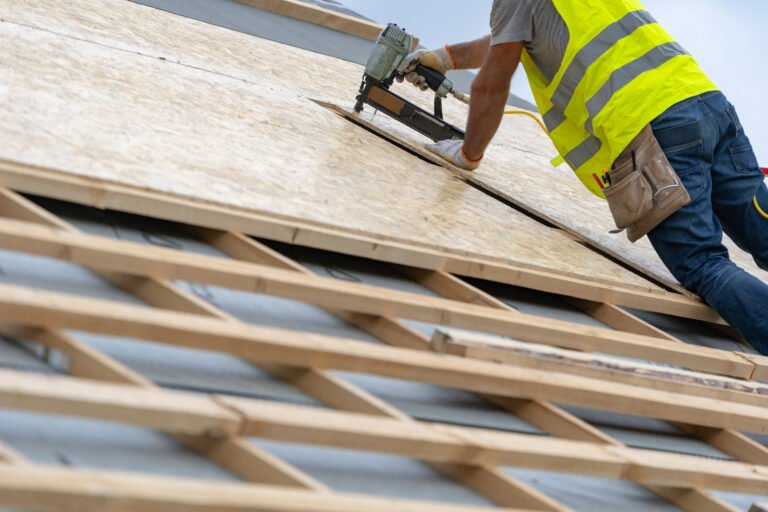Metal panels and shingles are efficient roof covers. But they need a solid platform to fasten themselves in harsh weather. That’s where roof decking comes into play.
Today, we’ll tell you about different roof decking types and materials to secure your roofs and add strength. Let’s explore more!
Key Takeaways
- The most common types of roof decking used for secure roofing are Plank, Sheet, Wood, Concrete, and Metal Decking.
- You can use plank decking for wide spans and high-pitched roofs. But, you must use a lighter sheet decking for low to mid-level spans.
- Sheet decking is well-insulated and provides optimal heat control in tropical areas. In contrast, plank decking is heat sensitive and needs an even climate.
- Wood, Concrete, and Metal are popular decking materials. But concrete and metal deckings are more durable than wooden ones.
- Concrete and Metal deckings are affordable, while wooden ones are costly and labor-intensive. But that’s not all! Read on to learn some more features too!
What Is Roof Decking & What Does It Do?
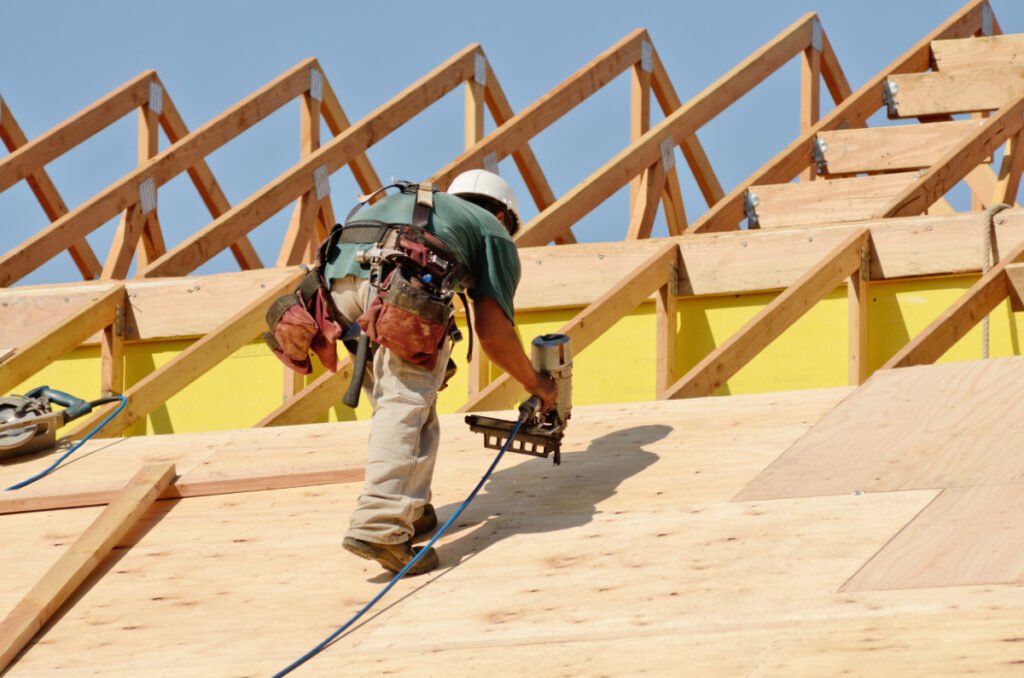
Roof decking is a thick packing that supports the shingles between the roof trusses and the apex. It creates a platform for the shingles to rest on and saves them from slipping in extreme weather.
Roof decking is essential for secure roofing because:
- It strengthens the shingles and reduces their breakage
- It seals all the shingle gaps and reduces leakage in the attic
- It helps even roof weight distribution along the trusses and rafters
- Roof decking reduces sagging and deformation of the roofline
- It acts like a fire-retardant and curbs the spread of fire
Where Should You Add Roof Decking?
Roof decking is usually installed between the different roof trusses and joists. But you can also install it in the following places for better reinforcement:
- Under the roof bracings or gusset plates
- Between the roof and the ceiling insulation
- Under the waterproofing or batt layer
- On the roof valleys and slopes
- Roof overhangs and skylights
Types of Decking Based on Design & Installation
Roof deckings aren’t universal and have different interlocking for various purposes. For example, some deckings are wider, while others are more grooved and easy to anchor.
So, let’s analyze different decking designs and pick the right one for your roof covers!
1. Plank Decking

A plank decking is a simple, interlocking mesh of 6 X 10 feet wooden boards anchored together by a V or grooved joint. Generally, this decking spans larger, planar roofs up to 12M. But you can use it for curvilinear roofs with elastic, silicone sealants.
Plank decking looks refined and is sturdier than commercial lumber. And its wooden sections resist damage and pests without heavy treatments and repairs.
However, plank decking is temperature-sensitive and might warp with continuous expansion and contraction. So, you must stagger the joints and seal them with the main rafter to avoid leaks. Or you can also fasten them with 2 – 3 wood screws to reduce splitting.
Lastly, you must follow some HOA rules while installing plank decking, or you might face a fine. Some of these rules are:
- The planks must be 1-½, 2-½, and 3-½ inches in size and must have a double tongue and groove at the thicker edges.
- You can use customized or sawn planks along the edges, but most of them should be 3m in size.
- You must verify the plank grade from the supplier and provide it to the contractor for an inspection.
| Average Cost | $4 – 13 per square foot |
| Popular Materials | Douglas Fir, Hemlock, Spruce, Pine, Red Cedar |
| Available Profiles | V-joint, Eased joint, Wirebrush, Grooved, Acoustical |
| Roof Covers | Heavier Concrete or Stone shingles, Metal roofs or Wood shakes |
Pros:
- Naturally resistant to pests and fungus
- Doesn’t need any surface treatments or stains
- Flexible to different roof shapes
- Supports larger spans and heavier roof covers
Cons:
- Fades and might discolor with time
- Warps and expands with moisture and heat
- Slightly expensive and labor-intensive
- Lower fire and deflection resistance
Use a minimum spacing of 2.5 feet between the screws and add a vapor barrier to reduce warping.
2. Sheet Decking
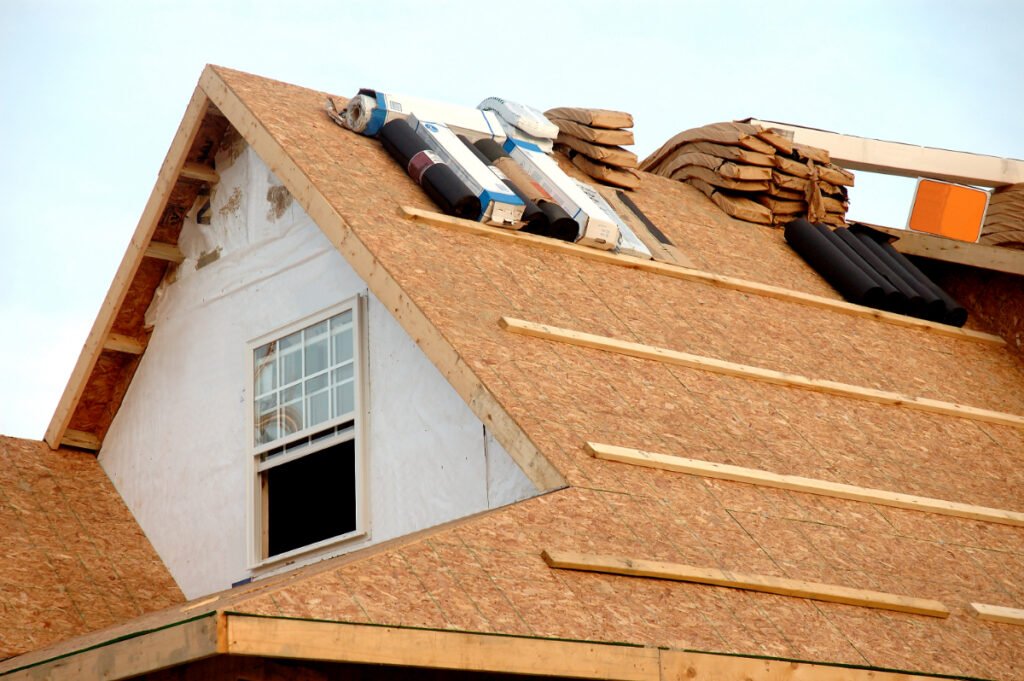
Decking sheets are plywood or OSB panels screwed to the rafters. They are pretty rigid and distribute the roofing weight evenly. And since they are thick, they reduce deflection and provide good tensile strength.
A sheet deck also have a thin layer of polyurethane foam between their layers. So, they provide better temperature control. They also absorb moisture and reduce weathering and corrosion of the roof above.
Sheet decking is used for low to mid-spans, but you can also use it with multi-layer roofs by adding steel clamps. But you’ll need professional labor and a lot of roof truss bracings to screw them properly.
Lastly, sheet decking already has some oil and fungicide treatments at the top. So you won’t have to worry about adding an underlayer or bitumen felt to repel pests. But make sure to use a sealant or roof flashing to divert the water and avoid leakage.
| Average Cost | $5 – 8 per square foot |
| Popular Materials | Steel, Galvanized Iron, Aluminum, and Cedarwood |
| Available Profiles | Corrugated, Grooved, Sectional, Tongue and Groove |
| Roof Covers | Lighter Steel, Aluminum or Copper shingles, Metal roofs, and Tiled roofs |
Pros:
- Easy to install and Lesser deflection
- Better corrosion and pest resistance
- Lighter slabs and reduced foundation loads
- Better moisture and leakage control
Cons:
- Needs professional labor for the mounting
- Lesser span
- Needs stronger steel purlins and rafters
Use thicker ¼ or ¾-inch decking sheets to add stability and reduce deflection in multi-layer roofs.
Types of Roof Decking Based on Materials
Decking materials impact the overall cost, weather resistance and durability of any roof. So, it’s necessary to pick the right decking to support the shingles and reduce slipping.
But what are the right materials? Let us find out below!
3. Wood Decking
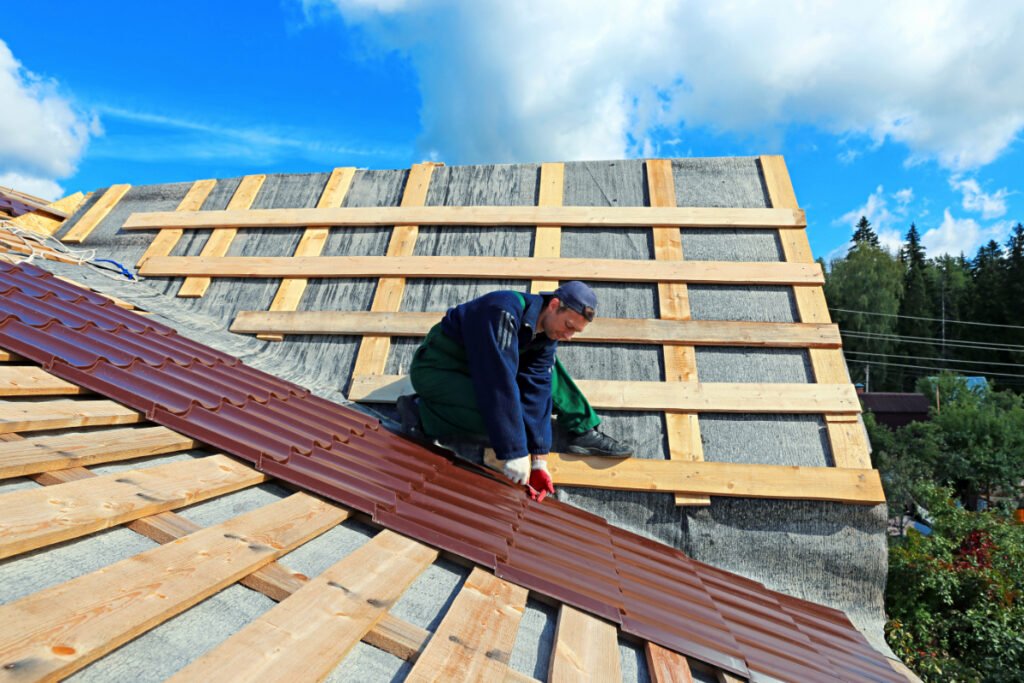
Strong and flexible wood decking is a great choice for customized roofs in humid areas. It does not bend easily and withstands heavy wind and rain without chipping or warping. Plus, it doesn’t expand with heat and looks seamless.
However, wood decking catches fire quickly. So, you must paint the decking with fire-retardant paint or add a barrier or insulation.
Wood decking is also more expensive and might discolor after 2-3 years. So, it’ll need frequent staining and repainting to maintain its shine. You must also coat it with fungicide and rinse it with any abrasive cleaner to drive off the fungus.
Average Cost: $15 – 25 per square foot
Top Composite Wood Boards for Decking:
- Zip Wood: Zip wood is a simple particle board with a plastic-like film for better moisture control. It is sturdier and minimizes the need for additional roof felt.
- FRT Plywood: FRT or Fire Resistant Plywood curbs the fire and reduces bending with long spans.
- CDX Plywood: It is durable, moisture-resistant plywood with extra insulation and waterproofing. It saves the decking from fungus.
- Oriented Strand Board: It is a thick chip board with resin pigments and a plastic-like surface. It is highly affordable and easy to install but isn’t that durable.
Use warm water and dish soap and scrub the wood decking with steel wool to remove the fungus and retain its shine.
4. Concrete Decking
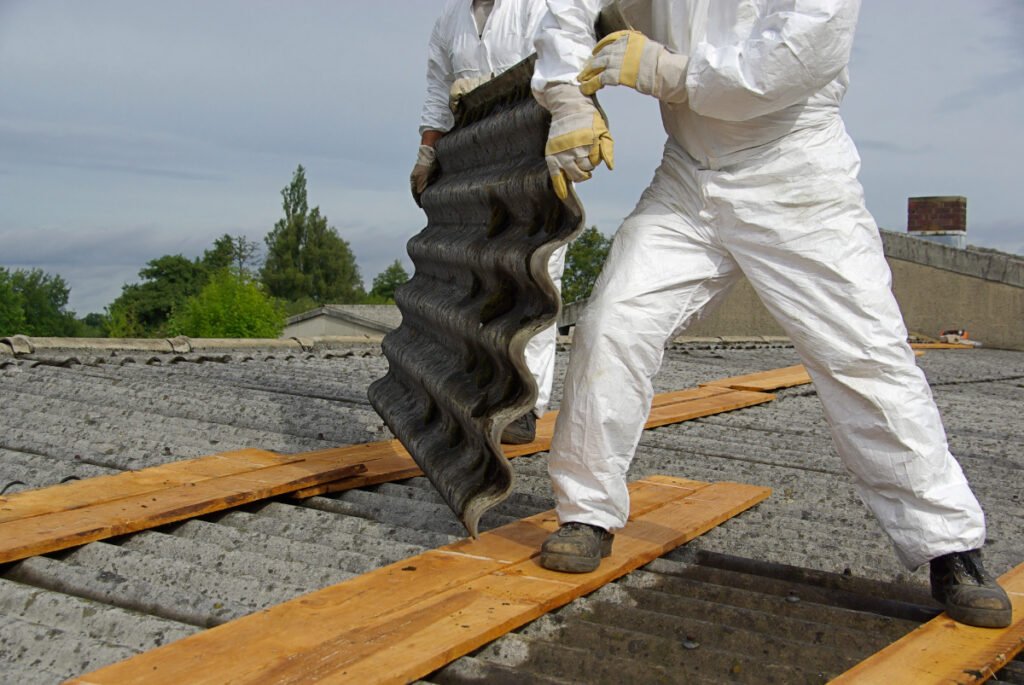
Concrete decking is a thick and sturdy roof decking for heavier ferrocrete roofs. It can even span over longer trusses of 20-25m. And its on-site construction provides a tight seal and doesn’t leave any gaps like typical wood planks.
However, concrete decking is very heavy. So, you must reinforce the trusses with more bracings and gusset plates. You can also add a steel mesh to reduce buckling due to any concentrated loads.
Concrete decks are also susceptible to warping and might catch fungus with moisture. So, you must add proper gutters and roof flashing to maintain its roofline. Or, you can polish it with plasticine paint or paraffin stain to save it from moisture.
Average Cost: $8 – 25 per square foot
Popular Types of Concrete Decking:
- Structural Concrete: It is a composite sheet of concrete boards and waterproofing layers. It is thick and supports heavier roofs and tiles in extreme climates.
- Lightweight Concrete: It is a non-structural concrete with a thin cross-section and curved profile. It is not that strong but can easily support lighter metal shingles, panels, and wood shake roofs.
Paint the concrete with a Class-A retardant paint or spray an intumescent spray to save it from burning.
5. Metal Decking
Metal deckings are thin, durable decking materials for pitched roofs. They are incredibly lightweight and can be directly welded to the roof trusses. Plus, they have unbeaten tensile strength and can handle different shingles easily.
These deckings can also withstand extreme weather. They do not warm up and thus maintain a comfortable temperature inside. So, they are also more energy-efficient and reduce maintenance.
However, metal roof decking is noisy and might dent or rust with moisture. So, you must galvanize or paint it for better leakage control. Or you can also add an insulating layer to absorb the extra moisture and reduce damage.
Average Cost: $6 – 12 per square foot
Best Metal Finishes for Roof Decking:
- Galvanized Metal: It is a zinc-coated panel for better moisture and rust control in a humid area. Being seamless and gap-free, this decking reduces leaks and provides better heat retention.
- Phosphatized Metal: It is a thick metal sheet that supports heavier concrete shingles over larger spans. But, it is not that moisture-resistant and needs cleaning and reglazing periodically.
Clean the metal decking and paint it with a durable epoxy or emulsion paint for more durability.
Tips to Pick the Right Decking for Your Roof Cover
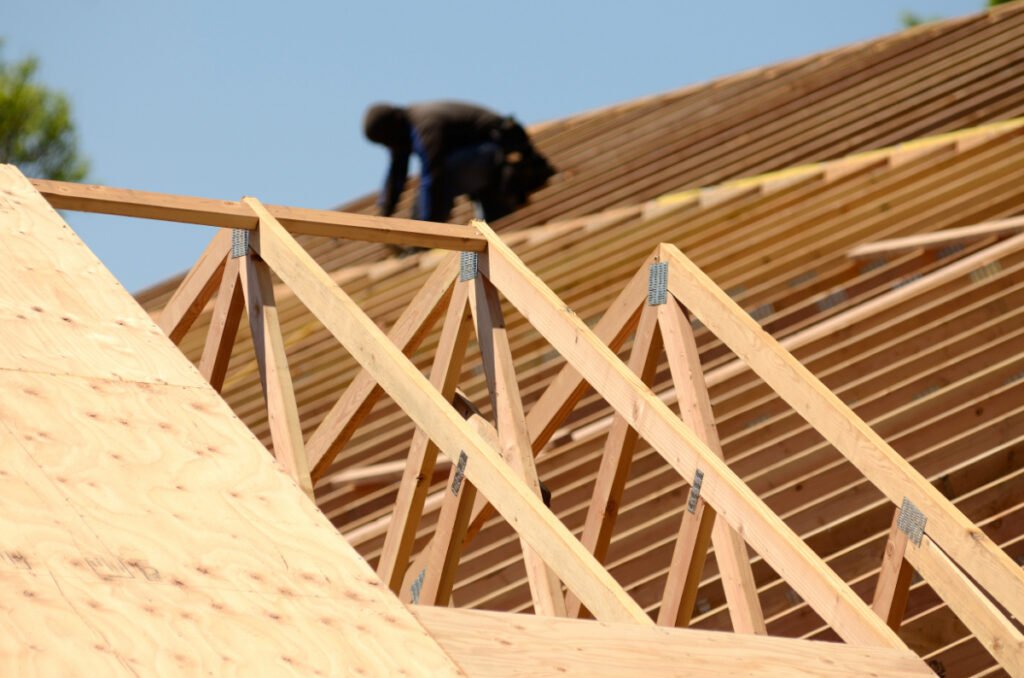
- Use a zip wood plank decking and add elastic, silicone sealants to install them along curvilinear roof shapes.
- Pick metal or concrete sheets and sandwich them with bitumen to control moisture in tropical areas.
- Use lighter alloyed or galvanized metal decking sheets for olden construction and rafters.
- Pick wooden sheet deckings for customized or multi-layer skillion roofs.
- Use good-quality roofing cement and baffles to reduce leaks in overlapping plank and wooden deckings.
How Thick Should Roof Decking Be?
Roof deckings should have a minimum thickness of 7/16 inches. But you can use 1-½ or 2-½ inch deckings for larger spans or heavier shingles.
Is Roof Decking Structural?
Roof decking does not hold the structural framework but holds the rafters and reduces displacement. So it retains the roofline and saves the roof from buckling.
How Thick Should Plywood Decking Be?
Plywood decking can be ½ – ⅝ inches thick in dry and sunny areas but must be 1-½ inches thick in tropical climates.
What Is the Thickness of Metal Roof Decking?
Metal roof deckings can be 2 – 5 gauge thick but must have 2.4 inch thick ribs to reduce sagging.
Roof decking creates an underlay for the shingles and protects them from breakage. So, you can add a plank or sheet decking along your rafters and seams. And you can even use materials like wood, concrete, and metal for better heat and water control.
Further, you can also install different roof vents to ventilate the roof and keep it dry. But what is a roof vent, and how to install one? Well, just scroll to our guide on ‘Common Roof Vent Questions’ to know all the answers.

